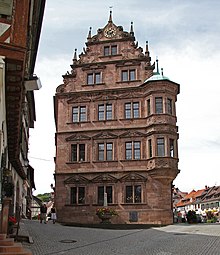Draft:Murgschifferschaft
| Submission declined on 16 February 2024 by HitroMilanese (talk). This submission is not adequately supported by reliable sources. Reliable sources are required so that information can be verified. If you need help with referencing, please see Referencing for beginners and Citing sources.
Where to get help
How to improve a draft
You can also browse Wikipedia:Featured articles and Wikipedia:Good articles to find examples of Wikipedia's best writing on topics similar to your proposed article. Improving your odds of a speedy review To improve your odds of a faster review, tag your draft with relevant WikiProject tags using the button below. This will let reviewers know a new draft has been submitted in their area of interest. For instance, if you wrote about a female astronomer, you would want to add the Biography, Astronomy, and Women scientists tags. Editor resources
|  |
 Comment: Might be a notable topic. However, additional references are essential. Please see WP:RS and WP:V and add references accordingly. Hitro talk 09:03, 16 February 2024 (UTC)
Comment: Might be a notable topic. However, additional references are essential. Please see WP:RS and WP:V and add references accordingly. Hitro talk 09:03, 16 February 2024 (UTC)

The Murgschifferschaft is a wood trading company based on a cooperative basis that has existed since the late Middle Ages in the Northern Black Forest. It is headquartered in Forbach (originally in Gernsbach) and manages forests in the upper Murg area. Its first documented regulations date back to 1488. The name component "Schiffer" ("boatman/raftsman") refers to the former most important method of transporting wood, which was log driving and timber rafting.
History[edit]
Since at least the 13th century, alongside viticulture and livestock farming, the timber trade has been one of the sources of income for the residents of Gernsbach and the villages in the Murgtal. Trees were felled, sawn, and rafted down the Murg and the Rhine. In the early 15th century, the timber trade was expanded, leading to the contractual regulation of the rights and obligations of the participants in 1488. The "Order of the Common Timber Trade in the Murg Valley" from that year contains 41 articles with nearly 400 individual points and is considered the birth certificate of the Murgschifferschaft. Once a year, the Murgschiffer gathered for the "Rügung," where they decided on disputes, punished violators of the order, and elected their leadership, the four "Hauptschiffer" ("main raftsmen").
During the Middle Ages, the Murgschiffer were granted forest usage rights by their feudal lords, the Counts of Eberstein and the Margraves of Baden. Towards the end of the 15th century however, they began acquiring their own properties. In 1569, Philipp II of Eberstein sold his sawmills and forests to the Murgschifferschaft in order to settle his debts. Similarly, Philipp II of Baden-Baden sold large forest areas to the Murgschifferschaft to finance the reconstruction of the New Castle in Baden-Baden.

Due to the lords' desire to expand their influence on the local economy, starting from the mid-16th century, the Murgschifferschaft was no longer represented by four, but only by a single main raftsmen. From 1587 until his death in 1615, Jakob Kast held this position.
For decades he exercised a state trade monopoly, sharing half of the net profit with the Margraves..[1] He had timber floated all the way to the Netherlands, and the proceeds from this business made him very wealthy (earning him the nickname "Fugger of Baden").
His contemporaries accused him of exploiting the other Murgschiffers. Nevertheless he further increased his wealth through credit transactions, leaving behind approximately 500.000 Gulden. His eldest son, Johann Jakob Kast, had the Old Town Hall built in Gernsbach, while his second eldest son, Philip Kast, succeeded Jakob as the main raftsmen.

In 1626 - during his tenure -, the Murgschiffers decided on a new shipping regulation, which included wage increases for the forest workers. Due to the Thirty Years' War and subsequent conflicts, there was a prolonged decline in the timber trade in the Murgtal region, which only ended in the mid-18th century. The Murgschifferschaft had no involvement in the export of large quantities of timber to the Netherlands, which began in the second half of the 18th century and was carried out by more financially powerful external companies. The Murgschifferschaft specialized in processed firewood and lumber with their sawmills, which also experienced increased demand due to population growth along the Rhine.
Until the beginning of the 19th century, the unplanned deforestation and unrestricted grazing in the forests led to extensive clear-cutting of large areas. By 1814, only a quarter of the Schifferwald ("raftsmen's forest") remained with usable trees. By 1833, the areas were reforested with spruces, firs, and pines based on the principles of sustainability as demanded by the Baden Forestry Laws.
Among other things, through the modernization of sawmills and their conversion into wood and paper factories, the members of the Murgschifferschaft, particularly their chairman of the board, the Reichstag representative Casimir Rudolf Katz, played a significant role in the industrialization of the Murgtal region.

In 1857, the guild supported the establishment of the Bezirkssparkasse Gernsbach (district savings bank) and provided interest on deposits. The treasurer and chairman of the board were Murgschiffer[2], and the bank opened in the office of the Murgschifferschaft[3]
The Murgschifferschaft was also a shareholder of the "Murgthal-Eisenbahn-Gesellschaft" (Murgtal Railway Company), which financed the construction of the first section of the Murgtalbahn railway from Rastatt to Gernsbach that opened in 1869. The railway gradually displaced rafting on the Murg by the beginning of the 20th century. At the end of the 19th century, the Murgschifferschaft reorganized its internal affairs and divided the communal property into 100.000 transferable forest rights. The state of Baden gradually bought shares in the following decades and became the majority owner.
Today's statutory goal of the Murgschifferschaft is to achieve a sustainable yield of valuable timber and profit. The largest shareholder, with approximately 55.000 forest rights, is the state of Baden-Württemberg.
